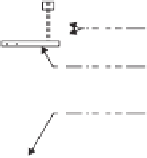Environmental Engineering Reference
In-Depth Information
The selection of a high-air-entry disk for testing an unsat-
urated soil should be primarily based upon the maximum
possible matric suction that can occur during the labora-
tory test. The initial matric suction in an unsaturated soil
specimen should be taken into consideration when select-
ing a ceramic disk for constant-water-content or undrained
tests. It must also be understood that the matric suction may
increase as the specimen is loaded to failure conditions.
The water coefficient of permeability and the thickness of
a high-air-entry disk are factors that affect the time required
for the pore-water pressure to equalize across the ceramic
disk. This information is of importance when assessing the
time required for consolidation prior to shearing the speci-
men as well as assessing the time required for shearing the
specimen. It is desirable to have the highest possible coef-
ficient of permeability (i.e., the largest possible pore size)
for the high-air-entry disk. This will ensure the most rapid
equilibration of the pore-water pressure in an undrained test.
It will also minimize impeded drainage of the pore-water in
a drained test.
The use of a thin air-entry disk reduces the time required
for pore-water pressure equalization throughout the soil
specimen. However, a thin ceramic disk means there is a
shorter pathway for air to diffuse and reach the underlying
water compartment. Air bubbles collect below the high-air-
entry disk as diffused air enters the water compartment. The
use of a thin ceramic disk results in a greater accumulation
of diffused air in the water compartment.
A thin ceramic disk also has a tendency to more easily
crack. Care must be taken to ensure that the total stress and
the pore-air pressure are applied to the soil specimen before
pressurizing the water compartment beneath the ceramic
disk. The removal of all pressures from the top of the disk
while a water pressure is applied to the bottom side of the
disk produces an upward bending moment that can readily
crack the ceramic disk. Experience has shown that an excess
uplift pressure greater than about 70 kPa on a 3.2-mm-thick
ceramic disk (63.5mm in diameter) can produce cracks in
the ceramic disk (Fredlund, 1973a). The cracks may not be
visible to the naked eye but are evident when checking the
air-entry value of the disk or testing for the permeability of
the disk. A 6.4-mm-thick disk can withstand higher uplift
pressures, but all ceramic disks should be checked for cracks
whenever subjected to an excess pressure greater than about
70 kPa.
11.4.2.1
Installation of High-Air-Entry Disk in Triaxial
Cell
Figure 11.31 shows the primary modifications that must be
made to a conventional triaxial cell when testing unsaturated
soil. The primary modification involves sealing a high-air-
entry disk onto the base pedestal of the triaxial cell. There
are several ways in which the high-air-entry ceramic disk
can be mounted, but in each case it is paramount that air not
be allowed to bypass the ceramic disk and find its way into
the water measuring system (i.e., the water compartment).
The installation of a high-air-entry disk onto the base
pedestal of a triaxial cell is illustrated in Fig. 11.32. The
most important feature of this modification is related to the
epoxy seal that is placed between the high-air-entry disk and
the base pedestal (see Fig. 11.32b). A tight seal between
the ceramic disk and the base pedestal ensures that air will
not leak into the water compartment. A series of grooves,
generally in a spiral pattern, should be machined onto the
pedestal. The grooves form a part of the water compartment
and serve as water channels for flushing air bubbles that may
become trapped below the ceramic disk or that may have
Top port
Loading ram
Top
Lucite
cylinder
Load cell
Cap
Rubber O-rings
Coarse
corundum disk
(3.17 mm thick)
To pore-water
pressure control
and volume
change indicator
Soil
High-air-entry disk
(6.35 mm thick, 5 bar)
Pore-air
pressure control
A
C
B
To flush
Pore water
pressure
transducer
D
Pedestal
To cell pressure control
Figure 11.31
Modifications to convert conventional triaxial cell for testing unsaturated soils.




















































Search WWH ::

Custom Search